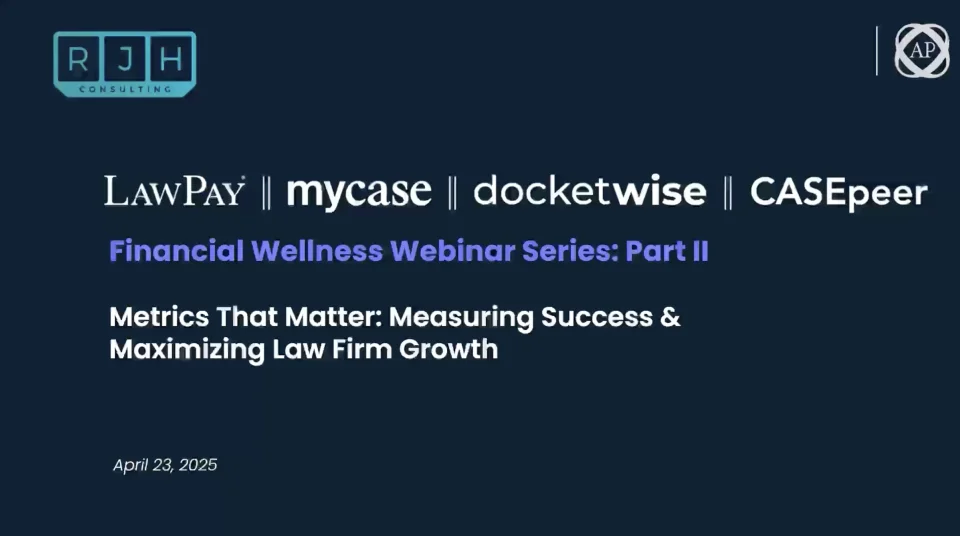Key takeaways
Consistent client feedback helps law firms identify service gaps and strengthen relationships.
Start by choosing one or two channels, like surveys or scheduled check-ins, to gather meaningful input without overwhelming your team.
To make sure every change moves the retention needle, firms can group and prioritize insights, roll out fixes, track KPIs, and iterate.
Collecting client feedback gives law firms direct insight into service quality, client satisfaction, and long-term growth opportunities. Treat it like data, and you’ll quickly spot ways to improve outcomes, retention, and referrals.
When you consistently capture client feedback, you can spot patterns, set measurable goals, and tighten every client touchpoint before small annoyances balloon into negative reviews or lost business. In this article, we’ll cover why client feedback matters for law firms, how to build a strong feedback program, and how law firms can create effective feedback surveys.
Why is it helpful for law firms to solicit client feedback?
Client feedback is one of the fastest ways to find and address service gaps before they turn into bad reviews or lost matters. Asking clients how you’re doing can provide real-time intel on what delights them, where they struggle, and which fixes will keep them loyal.
Feedback can also fuel smart business decisions for your firm. Instead of guessing which processes to streamline or tools to buy, you can back every decision with data straight from the people who pay the bills. For example, if clients want more predictable payment due dates, you may want to prioritize a better billing workflow to expedite invoice creation.
Over time, a steady feedback loop boosts your online reputation, too, which is essential for strong law firm reputation management.
Key benefits of gathering client feedback include:
Reduces client churn and helps to boost client referrals
Allows you to provide better and more personalized client service
Grow your practice with data-driven decision making
Improved attorney-client relationships
How can law firms create effective ongoing client feedback programs?
To create an effective client feedback program, law firms can implement a structured and ongoing approach that involves clear ownership, repeatable steps, metrics to track, and routine checkpoints with staff and clients.
Firms can tackle feedback programs and surveys in-house with simple tools and a shared template, while larger practices might benefit from third-party survey services that handle outreach and analytics at scale.
Either way, you can follow the five steps below to build a practical framework that scales up as your firm grows.
1. Identify goals and KPIs
Defining a clear outcome keeps feedback collection channels focused and prevents data overload. For starters, you can kick off every feedback program by asking, “What will success look like, and how will we measure it?”
Maybe you want to curb churn in your family-law practice or boost referrals for estate-planning matters. To make the goal clear, spell it out in one sentence and attach a metric.
Next, tie each goal to a key performance indicator (KPI) you’ll track every quarter. For example, “Raise repeat-matter retention from 60% to 75% in 12 months” lets you see progress at a glance and course-correct early to deliver exceptional client services in your law firm.
Sample KPIs to get you started:
Client retention rate: Percentage of returning clients who return for new matters
Client satisfaction score (post-matter): Rating that clients gives after their case concludes to rate their overall experience with your firm
Net Promoter Score (NPS): Score determining how likely clients are to recommend your firm, based on a 0–10 rating scale

2. Determine and implement feedback mechanisms
Once you know the numbers you want to move, pick tools that collect the right kind of data. A one-question pulse survey feeds your client-satisfaction KPI, while a short, post-matter interview uncovers the why behind the score. The goal is a steady feedback loop to gather insights, spot patterns, adjust, and repeat.
Choose channels your clients already use. In-app polls through a secure system like the 8am MyCase client portal feel seamless, while scheduled check-ins or post-engagement calls add a human touch.
For day-to-day clarity, you can encourage your team to log informal comments. Every one of these compliments or complaints is data you can use to improve lawyer-client communications.
Feedback touchpoints:
Surveys: Brief, KPI-tied questionnaires
Scheduled check-in meetings: Mid-matter pulse calls
Post-engagement interviews: 10-minute wins-and-gaps debrief
Informal staff notes: Quick comments captured during everyday interactions
3. Create a plan to take action on feedback
Collecting comments is only half the job. The real value comes from turning those insights into concrete improvements for your law firm.
Start by looping in the people who’ll make the changes, like attorneys, paralegals, and reception staff. Their front-line experience helps sort “nice-to-haves” from urgent fixes and builds buy-in so updates actually stick.
Next, give raw feedback a quick triage. For example, if multiple clients say email replies feel slow, tag those notes under “response time,” and gauge how often it appears. Then, you can decide whether you need better task reminders or client management skills training.
A single meeting can convert that theme into an action item like “respond to portal messages within 24 hours.”
A simple action plan framework:
Include staff at every step to secure buy-in
Analyze and group feedback by theme
Prioritize fixes based on impact and effort
Assign ownership and deadlines so nothing falls through the cracks
4. Roll out changes
Once you’ve mapped a fix, you can move quickly from whiteboard to real life, ideally with a small pilot first. For example, if slow response times topped your feedback list, you might adopt task reminders in your case management software. Test the new workflow for two weeks, track response-speed metrics, and gather mini-feedback before firm-wide launch.
Document every tweak in plain language: “All portal messages answered within 24 hours; paralegal checks the queue twice daily.” Store the SOP in a shared drive or practice-management wiki so new hires follow the same playbook and partners can audit compliance down the road.
Finally, announce the change to the whole firm, explaining what’s new, why it matters, and how it relates to client comments. Clear documentation plus a launch memo will keep everyone aligned today and as the firm scales.
5. Measure results and iterate
Once you roll out a change, you’ll need to verify if it worked. Rerun the KPI set in Step 1 and compare “before” and “after” numbers.
If your goal was faster response times, pull portal-message time stamps 30 days post-launch. Did the average turnaround drop from 48 hours to 20? If not, dig deeper: Is one practice group lagging? Are weekend queries still slipping?
To spot trends, slice the data by matter type or client profile. A criminal-defense shop, for instance, might learn that felony clients rate communication lower than misdemeanor clients. Keep the feedback loop tight. Send a micro-survey asking, “Have you noticed faster responses?” and capture fresh comments.
Finally, follow up with clients. A quick email saying, “You told us response times felt slow; here’s what we changed and the results so far,” shows you listened and helps build trust.
After closing that feedback loop, you can set a new target or refine the process and repeat. Continuous, data-driven tweaks turn a one-time fix into a long-term competitive edge.
How can law firms effectively run client feedback surveys?
The key to a useful law firm client feedback survey is making it simple to complete, laser-focusing on your goals, and following up with visible action.
Otherwise, you risk low response rates and burned goodwill. Start by tying every question to a KPI, then keep the survey short enough to finish in a coffee break.
Explain why the feedback matters, send it at a moment when clients are most engaged, and share what you changed to highlight your dedication. When surveys feel purposeful and painless, response rates climb, and insights stay fresh.
Quick tips for survey success:
Tell clients how their input improves service
Aim for under 10 questions or a five-minute completion time
Link every ask to a specific KPI
Include a mix of closed-ended and open-ended questions to capture both numbers and nuance
Allow clients to be anonymous to boost honesty, especially on sensitive topics
Send surveys right after a matter closes or mid-engagement on long cases
Share results and show the changes you made
Example client feedback survey questions
A good survey balances fast-to-score numbers with open-ended prompts that reveal the story behind the score. Below are sample questions you can copy-paste into your next form. Mix and match to fit the KPI you’re tracking.
Quantitative (score-based) questions:
On a scale of 1–10, how satisfied were you with our overall representation?
On a scale of 1–10, how satisfied were you with the timeliness of our responses?
Please rate our understanding of your case: Very satisfied / Satisfied / Neutral / Dissatisfied / Very dissatisfied
How easy was it to use our client portal? Very easy / Easy / Neutral / Difficult / Very difficult
How likely are you to recommend our firm to a friend or colleague? 0–10 (Net promoter score)
Qualitative (open-ended) questions:
What was the most helpful aspect of working with our firm?
Where could we have improved our service or communication?
Describe the biggest challenge you encountered during your case and how we might address it for future clients.
Were there any tools or resources you wished we had provided?
Is there anything else you’d like us to know about your experience?

Improve the law firm client feedback loop with 8am MyCase
You’ve seen how the right strategy can turn comments into client-retention gold, but many feedback pain points trace back to scattered systems. A streamlined legal case-management platform fixes those bottlenecks before they show up in a survey.
MyCase has built-in client communications tools and a secure client portal that pulls messages, documents, and updates into one hub, cutting the back-and-forth and giving clients real-time visibility. Fewer misfires mean better feedback, stronger relationships, and more referrals.
Schedule a demo and explore a workflow that keeps clients satisfied.
FAQ about law firm client feedback
About the author

Esther ParkContent Writer
Esther Park is a content writer and Senior SEO Manager for leading legal software companies, including MyCase, Docketwise, and CASEpeer, as well as LawPay, the #1 legal payment processor. Her expertise lies in writing about emerging legal technologies and financial wellness strategies for law firms, among other topics.
